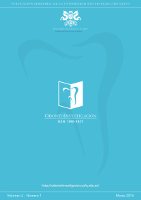Análisis clínico de la prevalencia de trastornos témporomandibulares en niños de 8 a 12 años de edad de la Escuela Diego Abad de Cepeda de la ciudad de Quito
Main Article Content
Abstract
The aim of this study was to determine the prevalence of temporomandibular disorders in children from 8 to 12 years old of the school “Diego Abad de Cepeda” in the city of Quito. The investigation was performed in 228 children who were divided into 128 women and 100 men, and signs of temporomandibular disorders were evaluated under observation method. The disorders assessed were pain, limited opening, deflection, joint sounds and discrepancy between centric relation and centric occlusion. The 49% of people had at least one of these disorders, being more prevalent in girls with 64%. The more prevalent disorders that people had were pain with 32% and joint sounds with 25%. Disorders were found more often in those children who had harmful habits, dental crowding, and malocclusions such as open bite, deep bite and crossbite. The obtained results of this investigation help us to confirm that temporomandibular disorders can also affect to children and impulse to dentists to learn more about the temporomandibular joint to know how to treat it properly.
Article Details
References
Raspall Guillermo. Cirugía Maxilofacial.Madrid, España. Segunda edición. EditorialMédica Panamericana. 2001.
Román Toni. Historia de la disfuncióntémporomandibular. 2010. Disponible enhttp://disfunciontemporomandibular-toni.blogspot.com/2010/10/historia-de-los-trastornos.html.
Casanova J., Jiménez G y Gutiérrez.Prevalencia y factores de riesgo asociadosa desórdenes témporomandibulares enuna población universitaria de Campeche,México en Revista ADM: Asociación DentalMexicana. 1998; (6): 261-265.
Serrano A. Fregoso C. Jiménez F. OcampoF. Frecuencia de la disfuncióntémporomandibular en niños. Odontologíaclínica. 2009;3 (2): 4-8.
Gutiérrez J. Radiología e imágenesdiagnósticas. Barcelona, España. Segundaedición. Corporación para investigacionesbiológicas. 2000.
Navarro C. Cirugía oral. Madrid, España.Primera edición. ARÁN. 2008.
Martínez I. Disfunción témporomandibularen población de 7 - 25 y más años de edad.Municipio Matanzas. Revista MédicaElectrónica. Matanzas, Cuba. 2006;28 (6).
Nilner M. Prevalence of functionaldisturbances and diseases of thestomatognathic system in 7-14 year olds.En Swed DentJ. 1983; (5): 189-197.
Nilner M, Lassing S. Prevalence offunctional disturbances and diseases ofthe stomatognathic system in 7-14 yearolds. En Swed Dent J. 1981. (5): 173-187.
Riva R, Sanguintti M, Rodríguez A, GuzzettiL, Lorenzo S, Álvarez R, Massa F.Prevalencia de trastornos témporomandibulares y bruxismo en Uruguay enOdontoestomatología Scielo Uruguay.Montevideo, Uruguay. 2011; 13 (17): 54-71.
Sánchez J, ATM y su relación con el tipo deoclusión dental, en un grupo de jóvenesmexicanos. Revista ADM. 2011; 68 (5): 237-243.
Corsini, G. Determinación de los Signos ySíntomas delos TrastornosTemporomandibulares, en estudiantes de9 a 12 años de un colegio de la comuna deTemuco, Chile. Int. J. Morphol. 2005;23 (4):345-352.
Myers D, Barenie J, Bel R, Williamson E.Condylar position in children withfunctional posterior crossbites: before andafter crossbite correction, Pediatr Dent.1980;2:190-194.
Wurgaft R, Wong R. TemporomandibularJoint Remodeling for the Treatment ofTemporomandibular Joint Disorders - AClinical Case Study. 2009;2:43-49.
Kavuncu V, Sezai S, Ayhan K. The role ofsystemic hypermobility and condylarhypermobility in temporomandibular jointdysfunction syndrome. Rheumatol Int.2006;26:257-260.
Okeson J. Tratamiento de oclusión yafeccionestémporomandibulares.Barcelona, España. Sexta edición.ELSEVIER. 2008.
Glaros A, Williams K, Lausten L. The role ofparafunctions, emotions and stress inpredicting facial pain. J Am Dent Assoc.2005;136 (7): 858-60.
Kino K. The comparison between pains,difficulties in function, and associatingfactors of patients in subtypes oftemporomandibular disorders. J OralRehabil. 2005;32 (5): 315-25.
Widmalm S, Christiansen R, y Gunn S. Oralparafunctions as temporomandibulardisorder risk factors in children. RevistaPaulista de Pediatría. 1995; (13): 244-246.
Cortese S y Biondi A. Relación dedisfunciones y hábitos parafuncionalesoralescontrastornostémporomandibulares en niños yadolescentes. ArchivoArgentinoPediátrico. Universidad de Buenos Aires,Argentina. 2009;107 (2): 134-138.
Okeson J. Temporomandibular disorders inchildren en The American Academy ofPediatric Dentistry. 1989;11 (4): 325-327.
Olsson M, Lindqvist B. Mandibular functionbefore and after orthodontic treatment.European Journal of Orthodontics. 1995;(17): 205-214.
Tanne K, Tanaka E, Sakuda M. Associationbetweenmaloclussionandtémporomandibular disorders inorthodontic patients before treatment.Journal of Orofacial Pain. 1993; (7): 156-162.
Williamson E. Temporomandibulardysfunction in pretreatment adolescentpatients. American Journal ofOrthodontics. 1977; (29): 433.
Nelson y Ash. Wheeler Anatomía, fisiologíay oclusión dental. Barcelona, España.Novena edición. ELSEVIER. 2010.43

